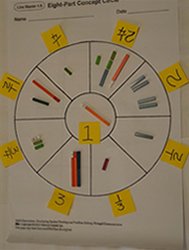
As I began to implement concept circles in my practice for vocabulary development in mathematics, a central idea in Math Expressions, I realized I wasn’t using this graphic organizer to its full potential. Yes, I did believe that it deepened students’ understanding of mathematical language (and I continue to use it in this way for vocabulary development in mathematics), but I was taken by its shape and wondered if I could use it beyond written words and images. What would happen if I enlarged the concept circle and used it to model mathematical concepts and mathematical relationships in a concrete way? I decided to explore the use of concept circles with math manipulatives. This was exciting! I found that by inviting students to engage in tasks in which they placed manipulatives directly on the concept circles the process helped them to develop math skills such as problem solving, mathematical discourse, spatial skills, modelling/representation, proportional reasoning (and the list goes on) all at the same time. I continued to explore this idea with a group of field-test teachers and found that concept circles provided
- rich opportunities for discussion, debate, and argumentation
- rich opportunities for discussion, debate, and argumentation
- targeted assessment, giving us insight into student thinking and helping us to identify potential misunderstandings at particular points of learning.
So, based on Nashville and other conferences, I’d like to share how I’ve used concept circles in my work with teachers and also share some wonderful samples/ideas that teachers have shared with me.
Marks Krpan, C. (2018). Teaching math with meaning: Cultivating self-efficacy through learning competencies. Toronto, Pearson Education Canada
Marks Krpan, C. (2012). Math expressions; Developing thinking and problem solving through communication. Toronto, Pearson Education Canada.
Vacca, J. L., Vacca, R. T., & Gove, M. K. (1987). Reading and learning. Glenview, IL: Scott, Foresman and Company.
Vacca, R.T., & Vacca, J. L. (1999). Content Area Reading: Literacy and Learning Across the Curriculum. Boston, MA: Longman.

 Recently I was in Nashville, presenting at the NCTM conference, where I shared examples of concept circles and their use. Similar to other presentations, the group asked, What are these concept circles and where can I find more information? I get this request a lot whether I am presenting in North America, Asia, or Europe. (Truth be told—for that exact reason—writing this blog has been on my list of things to do for some time.) I have done a lot of work with concepts circles and have written about them extensively in my book Teaching Math with Meaning (Pearson Canada, 2018) and before that in Math Expressions (Pearson Canada, 2012). In this blog, I’d like to share where the idea of concept circles originated, and how I used this original thinking first as a way to build vocabulary and then adapting the idea so concept circles could be used innovatively with manipulatives to develop deeper mathematical understanding at a variety of levels.
Recently I was in Nashville, presenting at the NCTM conference, where I shared examples of concept circles and their use. Similar to other presentations, the group asked, What are these concept circles and where can I find more information? I get this request a lot whether I am presenting in North America, Asia, or Europe. (Truth be told—for that exact reason—writing this blog has been on my list of things to do for some time.) I have done a lot of work with concepts circles and have written about them extensively in my book Teaching Math with Meaning (Pearson Canada, 2018) and before that in Math Expressions (Pearson Canada, 2012). In this blog, I’d like to share where the idea of concept circles originated, and how I used this original thinking first as a way to build vocabulary and then adapting the idea so concept circles could be used innovatively with manipulatives to develop deeper mathematical understanding at a variety of levels.